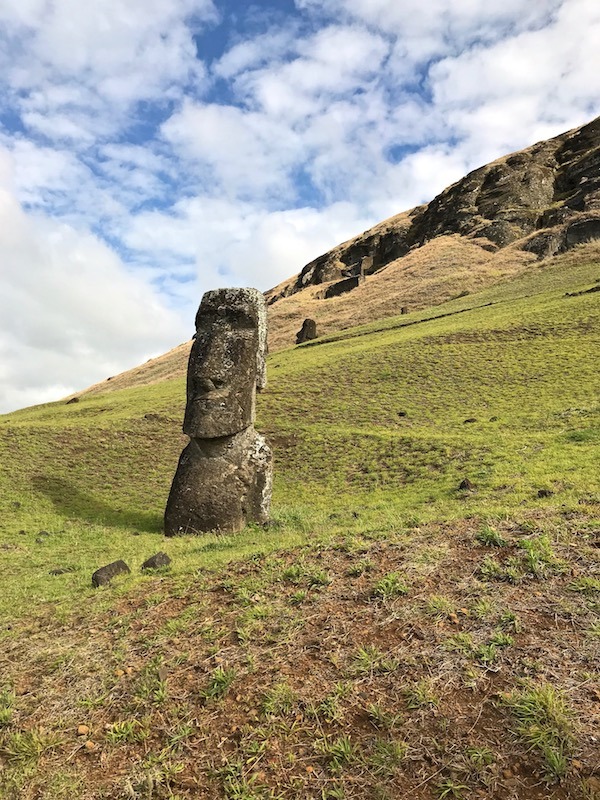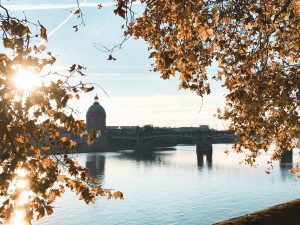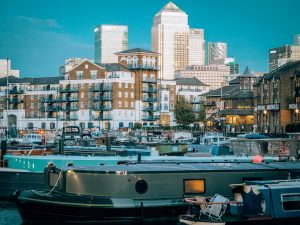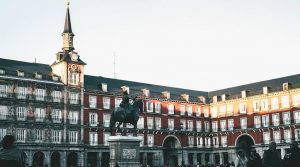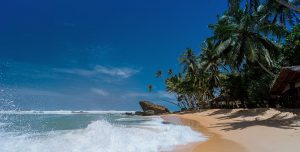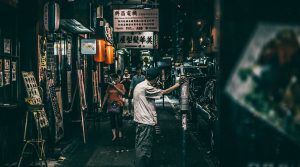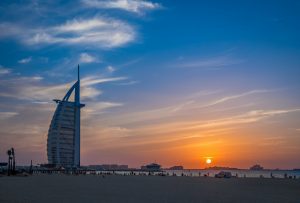Written From… Rapa Nui, Chile
Rano Raraku, the sacred quarry of the Rapa Nui – the one with the Easter Island heads – was not yet open. I should probably have double-checked the opening times. I could have spent the extra time admiring Ahu Tongariki a bit longer.
For some reason I assumed that Tongariki and Rano Raraku would be open at the same time. They were both heritage sites within Rapa Nui National Park, and they were nearby. But there again, Tongariki’s draw is its epic sunrise, so it would make sense to open it much earlier – before sunrise, obviously.
At first I killed time examining the scraggly shrubs and the odd wildflower that grew around the fence lines of Rano Raraku. Beyond it loomed Maunga Eo, the escarpment of rock from which the moai had been quarried and carved those long years ago.
It was buttressed all around by ridges covered by green grass, flowing down its sides to blend into the contours of the island. I could make out the enigmatic moai heads poking out of the ground on the side facing me.
Over on the other side, far in the distance I could still see Ahu Tongariki. The standing statues drew lines across the silver of the bay’s water like the teeth of a comb. The volcanic rise of Poike rose dramatically beyond, its waterline misty with sea spray vanishing into the morning.
Between Polynesian and Malaysian botany
My taxi driver came up to me. Observing me idly examining the plants in the park entrance area, he ventured to contribute. Alex’s English was sparse, and he mixed in Spanish words in the gaps. But fortunately, my even sketchier Spanish was just about enough to make out his meaning.
“Manioca,” he called the plant I was looking at. It was tapioca, or ubi, as my own people would call it. He pointed to a different ubi, one we call keladi. “Taro,” he said. I nodded, giving him my people’s names for them.
I turned to a plant I did not know. It had bunches of spiky fruit, even though its leaves were like tapioca. I asked Alex what it was. “Ra’a ka’u,” he said. Although he was not Rapa Nui, but mainland Chilean, he had given the Rapa Nui name. “The leaves are good for wounds,” he added.
Smiling at my seeming interest, he pointed to another plant, with bunches of long oblong leaves, and another that I may have seen before in my mother’s garden. “Tumu, and nga’oho,” he said respectively. I smiled, thinking how my mother would have loved this conversation, avid gardener that she is.
As for me, I was mostly enjoying the vestigial relatedness of our peoples, despite the distances of space and time.
He stooped to pick something up from near his feet. It was a seed pod, bright red seeds peeking out from the sooty nodes that had cracked open, fallen from the tree that was sheltering us.
The red was scarlet, looking exactly like saga seeds back home, though the pods were not the same. Alex told me that the Rapa Nui made jewelry out of those seeds. And indeed, later in the craft market in Hanga Roa, I found them sold as souvenirs.
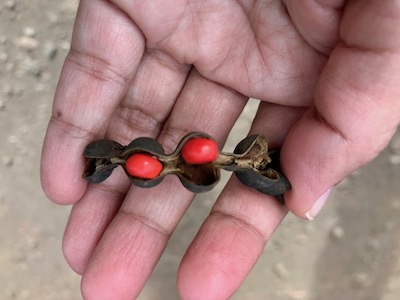
The two mountains
The ranger was still not yet arrived. Alex asked me where else I’d been. I was confused – elsewhere in the island, or elsewhere, period?
I have trouble figuring out the scale that people mean when they ask this. All seasoned travellers probably do, since where else is such a wide question when you’ve been so many places. Sometimes, they only mean, where else in their country. But indeed, Alex did mean where else, generally. Did I have pictures on my phone?
Struggling to choose one, not wanting to make the faux pas of running a list, I blurted out “Nepal”. I told him where it was, and how the mountain was even higher than the Andes – the Himalayas had Mt. Everest, the tallest in the world. But that was not where I went; I had gone to Annapurna.
I showed him pictures of my trek, and told him how laborious it had been. But then I showed him the snowy views at Annapurna Base Camp, for which the labour was done. He looked at it for a moment, then asked me, how long did it take to get up there?
“Seven days,” I said. Rano Raraku is 21 metres, he said. It is ‘muy grande‘. I nodded, deciding it was not necessary to mention that Annapurna Base Camp was 4000.
A matter of perspective
We stood in silence for a little while. Then, furtively, Alex asked, “Are you married? Do you have a husband?” I felt myself tense at the question, wondering its intent.
A common question directed to solo female travellers, I am nevertheless not as triggered by it as others seem to be, perhaps due to my highly family-centric Asian background. I do not necessarily project judgmental intent to the question. Sometimes it is mere curiosity. And sometimes, if you are without the protection of a husband (in their worldview), they are considering to ‘adopt’ you to grant it in lieu.
What I’m more wary of is when the question really means, ‘are you single?’ So I watched Alex’s reaction, when I told him frankly that I am divorced.
He was only mildly surprised. Nor did he do that annoying thing people often do – that look of sadness, or perhaps pity, as if divorce needs to pain you for all your life. But what he shared next, made things clear. “I am divorced also.”
And he told me of his ex-wife, and his children left on the continent with her. He works on the island for their support, and has not gone back for a long time.
That’s life. The reality of 90% of the world who never grew up expecting the world to stay stable just for them. But you roll with it, that’s all you can do. So we simply compared our separate circumstances, and the exchange itself was enough. And it’s not sad.
From botany to food
He asked me then, what we ate in Malaysia. Rice, like the rest of Asia. A lot of seafood, because we have a long coastline. But what did I eat it with? What ingredient is most used?
“Oh, chilli,” I replied automatically. He looked puzzled and I repeated, “You know, chilli!” even as I inwardly kicked myself. You fool, he’s wondering how you could be eating his country, Chile!
But what was the Spanish word for chilli? My mind went blank. My vocabulary had run out, and my phone couldn’t help me. There was no travellers’ SIM card in Chile, and I had not downloaded the Spanish dictionary into my translation app.
Well, he’s from South America! Your mother buys chilli seeds online from there! Think! My mother had a chilli phase during which she ordered all sorts of weird chilli seeds, even though she herself could not tolerate the heat.
Some of the weirdest and hottest were South American. And a lightbulb flashed. A memory of my mother, insisting on telling me the local name for the novelty peppers that she hoarded.
“Aji!” I cried. Alex’s face cleared like daybreak. He smiled in what I took as approval for our chilli-centric cuisine. I asked him then about Chilean cuisine, especially since I was headed there next.
But at that moment Alex spied the ranger, who had finally arrived to open up Rano Raraku. He motioned for me to hurry after. The comparisons would have to wait.
